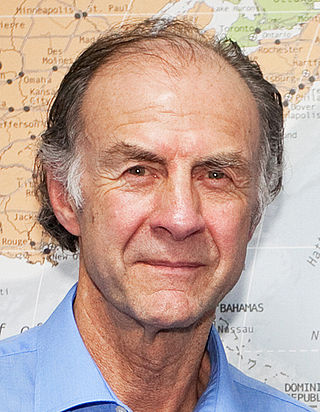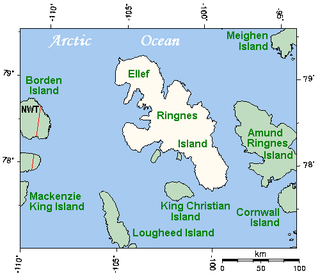
James Daniel May is an English television presenter and journalist. He is best known as a co-presenter, alongside Jeremy Clarkson and Richard Hammond, of the motoring programme Top Gear from 2003 until 2015 and the television series The Grand Tour for Amazon Prime Video from 2016 to 2024. He also served as a director of the production company W. Chump & Sons, which has since ceased operating.

Isachsen is a remote Arctic research-weather station named after the Norwegian explorer of the Arctic, Gunnar Isachsen. It is on the western shore of Ellef Ringnes Island in the Sverdrup Islands, in the territory of Nunavut in Canada. Isachsen Station was established to participate in a joint Canadian-American weather observation program. Isachsen Station operated from April 3, 1948, through September 19, 1978. Regular weather observations began on May 3, 1948. In October 1949, a Douglas C-47 Skytrain crash-landed near the station. No one was killed, but three on board were injured. The wreckage has been preserved by the cold weather and dry conditions.

Sir Ranulph Twisleton-Wykeham-Fiennes, 3rd Baronet, commonly known as Sir Ranulph Fiennes and sometimes as Ran Fiennes, is a British explorer, writer and poet, who holds several endurance records.

Ellef Ringnes Island is an uninhabited island and one of the Sverdrup Islands in the Qikiqtaaluk Region, Nunavut, Canada. A member of the Queen Elizabeth Islands and Arctic Archipelago, it is located in the Arctic Ocean, east of Borden Island, and west of Amund Ringnes Island. It has an area of 11,295 km2 (4,361 sq mi), making it the 69th largest island in the world and Canada's 16th largest island. Its highest mount is 260 m (850 ft).

Resolute or Resolute Bay is an Inuit hamlet on Cornwallis Island in Nunavut, Canada. It is situated at the northern end of Resolute Bay and the Northwest Passage and is part of the Qikiqtaaluk Region.
Paul Landry M.B. is a French-Canadian polar explorer, author, and adventurer who is the only paid man to ever reach three Geographical poles in a single year.
The Polar Challenge was a competitive, 350 nautical mile team race taking place in the Arctic, to the 1996 location of the Magnetic North Pole. The race ran between mid-April and mid-May each year, taking teams approximately 4 weeks to complete, including the training time. This event should not be confused with the Polar Race, which was a different event taking a different route, and run by a different organisation.
Matty L McNair is an American explorer. She now lives in Iqaluit, Nunavut, Canada on Baffin Island. Among her many accomplishments are:
Series 9 of Top Gear, a British motoring magazine and factual television programme, was broadcast in the United Kingdom on BBC Two during 2007, and consisted of six episodes that were aired between 28 January and 4 March. Production on the series was delayed by several months when Richard Hammond was seriously injured after crashing the Vampire dragster racer whilst filming for the show; the first episode, which welcomed him back, showed the footage of this crash. This series was the first to introduce feature-length specials focused on road trips with motoring challenges, with other highlights including the presenters attempting to build a Space Shuttle with a Reliant Robin, creating home-made stretch limos, and reaching top speed in the Bugatti Veyron.
Top Gear challenges is a segment of the Top Gear television programme where the presenters are tasked by the producers, or each other, to prove or accomplish various tasks related to vehicles.

Top Ground Gear Force was a one-off TV special, featuring the presenters of BBC's Top Gear, which originally aired on BBC Two at 22:00 GMT on 14 March 2008 as part of Sport Relief 2008. It was repeated on Easter Monday, 2008.
In Top Gear, a BBC motoring show, one of the show's regular features since 2002 is various forms of racing the presenters undertake, either against each other or against invited guests. The show has featured a number of epic races, where one of the presenters — Jeremy Clarkson, Richard Hammond, James May, and occasionally The Stig — drives a car in a race against the others in another form of transport. These races typically involve Clarkson driving the car while Hammond and May take the same journey by combinations of plane, train, or ferry. May has said that the races are planned to be as close as possible. Of the long-distance races so far, the car has won the vast majority of the races, with the exceptions of the cross-London epic, in which the car was beaten by a bicycle, a boat on the Thames and public transport; Ferrari Daytona vs. Powerboat, in which the boat won; Shelby Mustang GT500 vs. High Speed Train, in which the train won; and the Arabian Peninsula race, in which the alternative 'money no-object' transportation options beat the Bugatti Chiron.

Top Gear: Winter Olympics is a full-length, special edition episode for BBC motoring programme Top Gear, and is the first in a series of full-length specials for the show. The episode was aired on 12 February 2006, with a repeat of the episode being aired a week later on 19 February. The special saw hosts Jeremy Clarkson, Richard Hammond and James May travelling to Lillehammer, Norway and creating their own version of the Winter Olympics with cars. The episode was later released on DVD on 5 June later that year.
Top Gear: Vietnam Special is a special 75-minute episode for BBC motoring programme Top Gear, and was first broadcast on 28 December 2008, as part of the final episode for the twelfth series, with the special repeated for UK TV channel Dave, initially in an edited, 46 minute version on 19 January 2009, but later revised to a 90-minute format following complaints by viewers. The special sees hosts, Jeremy Clarkson, Richard Hammond and James May, travelling 1,000 miles (1,600 km) across Vietnam with motorbikes, beginning from Ho Chi Minh City (Saigon), travelling north towards Hạ Long city, and finishing at a floating bar within Hạ Long Bay, a journey that had to be completed within eight days.

Arctic Trucks is a company in Iceland with operations in the United Kingdom, North America, Norway, Finland, Poland, Sweden and the United Arab Emirates. They specialize in the re-engineering and after-market tuning of four-wheel drive vehicles to be used in challenging conditions.

Arctic exploration is the physical exploration of the Arctic region of the Earth. It refers to the historical period during which mankind has explored the region north of the Arctic Circle. Historical records suggest that humankind have explored the northern extremes since 325 BC, when the ancient Greek sailor Pytheas reached a frozen sea while attempting to find a source of the metal tin. Dangerous oceans and poor weather conditions often fetter explorers attempting to reach polar regions, and journeying through these perils by sight, boat, and foot has proven difficult.

The north magnetic pole, also known as the magnetic north pole, is a point on the surface of Earth's Northern Hemisphere at which the planet's magnetic field points vertically downward. There is only one location where this occurs, near the geographic north pole. The geomagnetic north pole is the northern antipodal pole of an ideal dipole model of the Earth's magnetic field, which is the most closely fitting model of Earth's actual magnetic field.
Top Gear is a British motoring magazine and entertainment television programme. It is a revival by Jeremy Clarkson and Andy Wilman of the 1977–2001 show of the same name for the BBC, and premiered on 20 October 2002. The programme focuses on the examination and reviewing of motor vehicles, primarily cars, though this was expanded upon after the broadcast of its earlier series to incorporate films featuring motoring-based challenges, special races, timed laps of notable cars, and celebrity timed laps on a course specially-designed for the relaunched programme. The programme drew acclaim for its visual and presentation style since its launch, which focused on being generally entertaining to viewers, as well as criticism over the controversial nature of its content. The show was also praised for its occasionally-controversial humour and lore existing in not just the automotive community but in the form of internet memes and jokes. The programme was aired on BBC Two until it was moved to BBC One for its twenty-ninth series in 2020.










